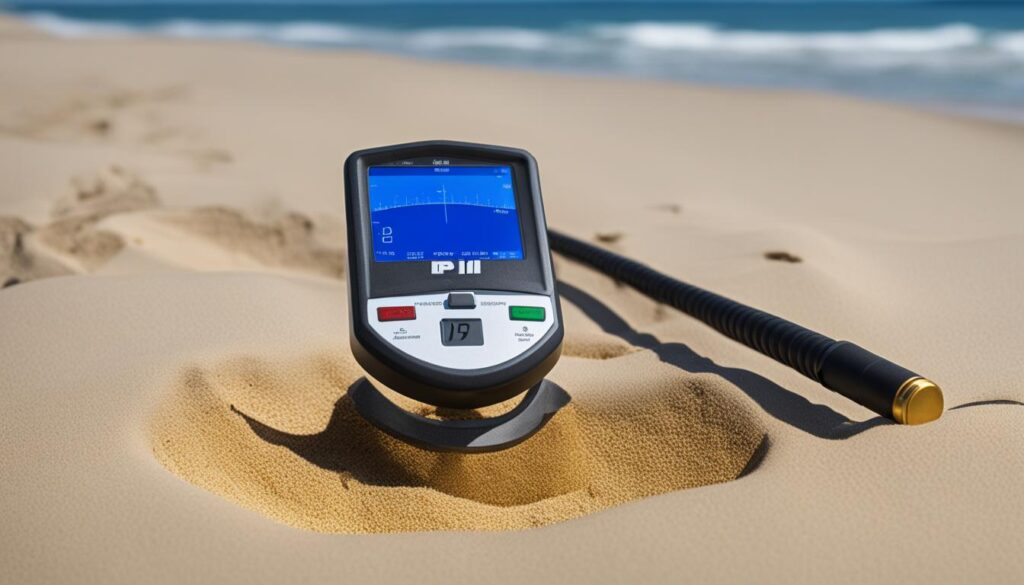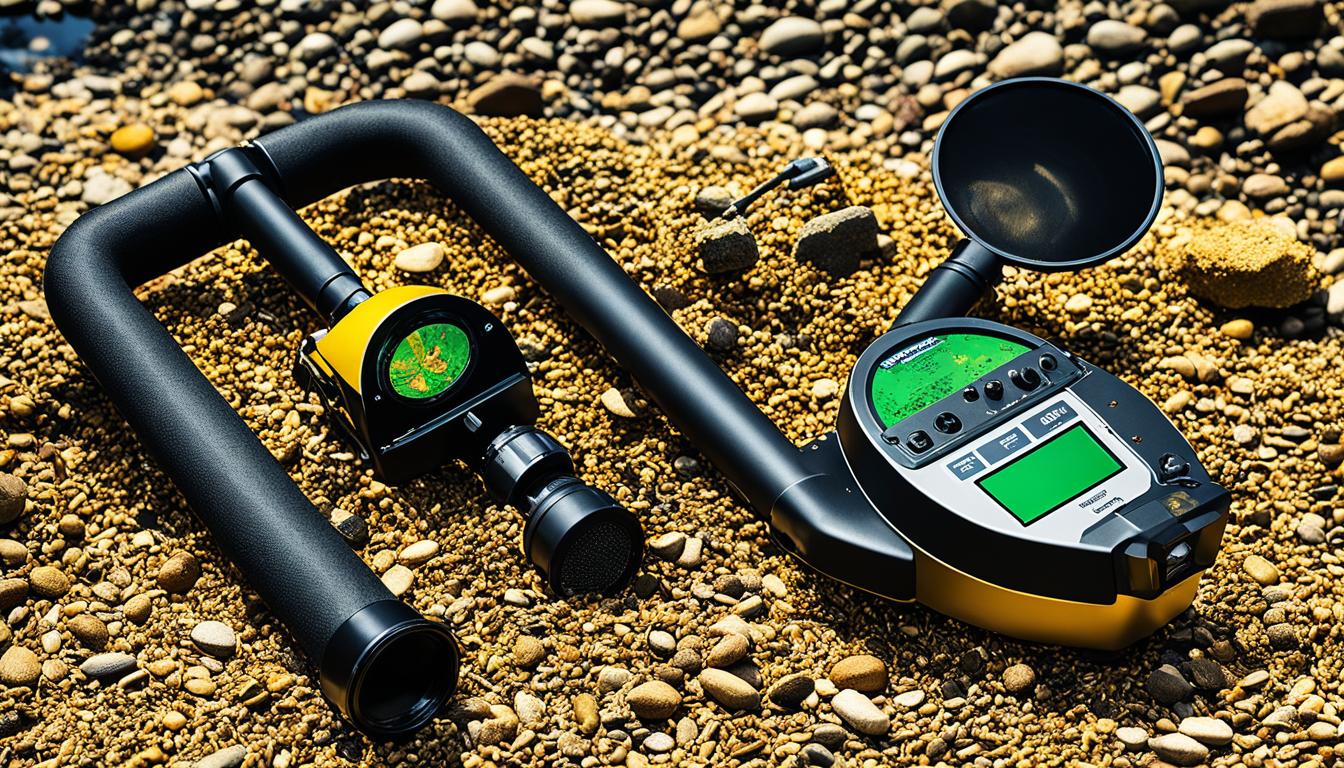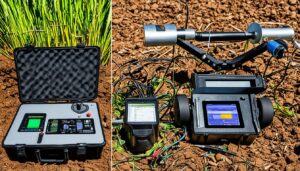Disclaimer: We may earn a commission from affiliate links.
Welcome to our beginner’s guide to metal detectors! If you’ve been curious about metal detecting and want to embark on your treasure hunting journey, it’s important to understand the different types of metal detectors available in the market. With the right knowledge, you can choose the metal detector that best suits your needs and preferences.
Today, there is a wide range of metal detectors designed for various purposes and environments. From coin and treasure hunting to gold prospecting, each type of metal detector comes with its own set of features and capabilities. By familiarizing yourself with the different types, you can make an informed decision and enhance your chances of finding valuable discoveries.
In this guide, we will discuss the main types of metal detectors, their features, and their suitability for different purposes. Whether you are a beginner or looking to upgrade your current detector, this guide will provide valuable insights to help you make the right choice. Let’s dive in!
Key Takeaways:
- Understanding the different types of metal detectors is crucial for beginners.
- There are various types of metal detectors available in the market, each designed for different needs and environments.
- Metal detectors have advanced significantly in terms of technology, weight, and efficiency.
- VLF and PI metal detectors are the two main types used by metal detecting enthusiasts.
- Choosing the right metal detector is essential for a successful treasure hunting experience.
The First Commercial Metal Detector For Treasure and Gold Detecting
In 1925, Gerhard Fischer, a German immigrant living in California, created the first commercially designed handheld and portable metal detector known as the Metallascope or M-scope. This groundbreaking invention marked a significant milestone in metal detector history, revolutionizing the field of treasure and gold detecting.
Fischer went on to establish Fisher Research Labs, the oldest metal detecting company in the world. Renowned for its advanced electrical products, Fisher Research Labs continues to be one of the major manufacturers of high-quality metal detectors to this day.
Fischer’s innovative creation opened up new possibilities for treasure hunters and gold prospectors, enabling them to more effectively search for valuable artifacts and precious metals. The commercialization of metal detectors paved the way for further advancements in technology, making metal detecting accessible to enthusiasts around the world.
Modern Day Metal Detectors
Over the years, metal detectors have undergone significant advancements in terms of technology, weight, and efficiency. With the introduction of new manufacturing techniques and the entry of various manufacturers into the market, metal detectors have become lighter, more energy-efficient, and packed with features suitable for all ages and experience levels. These advancements have made metal detecting a popular hobby that can be enjoyed by a wide range of enthusiasts.
Modern metal detectors incorporate state-of-the-art technology to enhance detection capabilities. They utilize advanced signal processing algorithms and multi-frequency operation to improve target identification and discrimination. These detectors can differentiate between various types of metals, allowing users to focus on valuable targets and ignore unwanted objects.
Key Advancements in Metal Detector Technology
- Improved Sensitivity: Modern metal detectors are highly sensitive and can detect even the smallest metallic objects buried deep in the ground.
- Enhanced Depth Range: Advanced detection coils and circuitry enable metal detectors to reach greater depths, opening up new possibilities for treasure hunters.
- Target Identification Features: Many modern detectors offer visual target identification displays, providing valuable information about the type of metal detected.
- Waterproof Designs: Some metal detectors are designed to be fully submersible, allowing users to search for treasures in shallow water or wet environments.
- Wireless Technology: Wireless headphones and Bluetooth connectivity have made metal detecting more convenient and hassle-free.
“The advancements in metal detector technology have revolutionized the hobby of metal detecting. With modern detectors, enthusiasts can explore a wide range of terrains and uncover treasures that were once inaccessible.” – Metal Detecting Magazine
Comparing Modern Metal Detectors
| Brand | Model | Features | Price |
|---|---|---|---|
| Garrett | Ace 400 | Adjustable frequency, iron audio, digital target ID | $349.95 |
| Minelab | Equinox 800 | Multi-frequency operation, wireless audio, waterproof design | $899.00 |
| Bounty Hunter | Land Ranger Pro | Manual ground balance, adjustable discrimination, 7 search modes | $399.00 |
| XP | Deus | Wireless operation, customizable programs, lightweight design | $1,299.00 |
VLF Metal Detectors
VLF (Very Low Frequency) metal detectors are widely used by metal detecting enthusiasts due to their versatility and effectiveness in various applications. These detectors operate on lower frequencies and offer a range of features that make them suitable for coin and treasure hunting, as well as gold prospecting.
VLF metal detectors utilize a two-coil detection system to locate objects beneath the surface. This system allows for precise target identification and discrimination between different metals. Whether you’re searching for valuable coins or exploring for hidden treasure, a VLF metal detector can provide accurate and reliable results.
One of the key advantages of VLF metal detectors is their sensitivity to small targets. This means that even tiny fragments of valuable metals can be detected, increasing your chances of finding hidden treasures. Additionally, VLF detectors typically come equipped with advanced on-screen target identification, allowing you to distinguish between different types of metals and accurately assess the value of your finds.
Features of VLF Metal Detectors:
- Lower frequency operation for enhanced sensitivity
- Two-coil detection system for precise target identification
- On-screen target identification for metal classification
- Ability to discriminate between different metals
- Lightweight and portable design for easy transportation
Whether you’re a beginner or an experienced metal detectorist, a VLF metal detector can be a valuable tool in your treasure hunting endeavors. These detectors offer a combination of sensitivity, versatility, and user-friendly features that make them an excellent choice for all types of metal detecting enthusiasts.

| Pros | Cons |
|---|---|
| High sensitivity to small targets | Can be affected by mineralized soils |
| Ability to discriminate between different metals | Less depth penetration compared to pulse induction detectors |
| Wide range of features and settings | Not ideal for highly mineralized or iron-rich ground |
| Lightweight and portable design |
Pulse Induction Metal Detectors
When it comes to gold prospecting, Pulse Induction (PI) metal detectors are a game-changer. These detectors are renowned for their exceptional depth detection capabilities and their ability to handle highly mineralized and iron-rich ground.
Unlike VLF detectors, PI detectors operate using a single coil to send and receive signals. This unique design allows them to detect targets at greater depths while ignoring unwanted metals and minerals. Although they may not be as versatile as VLF detectors, PI detectors excel in challenging terrains where gold is abundant.

| Advantages of Pulse Induction Metal Detectors | Limitations of Pulse Induction Metal Detectors |
|---|---|
|
|
Best Metal Detectors for Beginners
Choosing the right metal detector for beginners is essential for a successful treasure hunting journey. Several models are highly recommended for beginners, including the Garrett Ace 200i, Garrett ACE 300, and Bounty Hunter Tracker IV. These detectors are user-friendly, lightweight, and offer features like adjustable discrimination, target ID, and depth indicators. They are designed to provide beginners with a smooth learning curve and a satisfying detecting experience.
When starting out in metal detecting, it’s important to have a detector that is beginner-friendly and easy to use. The Garrett Ace 200i is a popular choice for beginners due to its simplicity and affordability. It offers excellent target separation, allowing you to distinguish between different metals and eliminate unwanted targets. With its robust design and lightweight construction, the Garrett Ace 200i is portable and comfortable to use for extended periods.
If you’re looking for a step-up in features and performance, the Garrett ACE 300 is a great option. It comes with enhanced iron discrimination, allowing you to filter out unwanted iron targets and focus on valuable objects. The ACE 300 also features a higher frequency for improved target separation in trashy environments and better sensitivity to small targets. With its digital target ID display and depth indicator, the Garrett ACE 300 provides valuable information to beginners as they learn to interpret different signals.
Another beginner-friendly option is the Bounty Hunter Tracker IV. This detector is known for its simplicity and ruggedness. It has a straightforward interface with just two knobs for sensitivity and discrimination settings. The Tracker IV also offers a built-in speaker and headphone jack for clear audio feedback. With its lightweight design and ergonomic handle, the Bounty Hunter Tracker IV is comfortable to use for long detecting sessions.
“The Garrett Ace 200i and ACE 300 are great metal detectors for beginners. They are easy to use, offer excellent features, and deliver solid performance in various detecting scenarios.” – John Davis, Metal Detecting Enthusiast
Whether you choose the Garrett Ace 200i, Garrett ACE 300, or Bounty Hunter Tracker IV, these metal detectors are excellent options for beginners. Their user-friendly features, lightweight design, and affordability make them ideal for those new to metal detecting. Start your treasure hunting journey on the right track with one of these beginner-friendly metal detectors.
Conclusion
Embarking on a treasure hunting journey is an exciting endeavor, and understanding the various types of metal detectors is crucial for beginners. Whether you’re interested in versatile coin and treasure hunting or venturing into gold prospecting, there is a metal detector suitable for every enthusiast.
For versatility and target discrimination, VLF (Very Low Frequency) metal detectors are highly recommended. These detectors are ideal for beginners as they offer features like adjustable discrimination and on-screen target identification. They are perfect for uncovering hidden treasures on beaches, parks, and other common hunting grounds.
On the other hand, if your focus is on finding gold nuggets in highly mineralized soil, a Pulse Induction (PI) metal detector is the way to go. These detectors excel in challenging terrains and offer exceptional depth detection. While they may require a bit more experience to master, their ability to ignore unwanted metals makes them valuable tools for serious gold prospectors.
Lastly, when choosing a metal detector, consider factors such as your budget and level of experience. There are beginner-friendly options available, such as the Garrett Ace 200i, Garrett ACE 300, and Bounty Hunter Tracker IV. These detectors are user-friendly, lightweight, and equipped with features that make learning easy and enjoyable.
With the right metal detector in your hands, you’re ready to embark on exciting adventures, uncover hidden treasures, and make lasting memories. So, go ahead and start your treasure hunting journey with confidence, knowing that you have the knowledge to choose the perfect metal detector for your needs!
Source Links
- https://detectorsdirect.com.au/blogs/detector-articles/the-ultimate-metal-detector-guide-for-beginners-2020
- https://regton.com/blog/2022/06/29/beginners-guide-to-the-best-metal-detectors/
- https://www.linkedin.com/pulse/best-metal-detectors-beginners-discovering-treasures-kazantsev-5v0se

Meet Ryan Conlon, the passionate owner and driving force behind Pan for Treasure.
With an unwavering love for the art of gold panning, Ryan has transformed his enthusiasm into a thriving community hub for fellow treasure seekers. [email protected]
A seasoned gold panning enthusiast, Ryan’s journey began with a simple pan and a dream, evolving into a deep appreciation for the history, geology, and thrill of uncovering precious metals.
Subscribe to Our Newsletter




